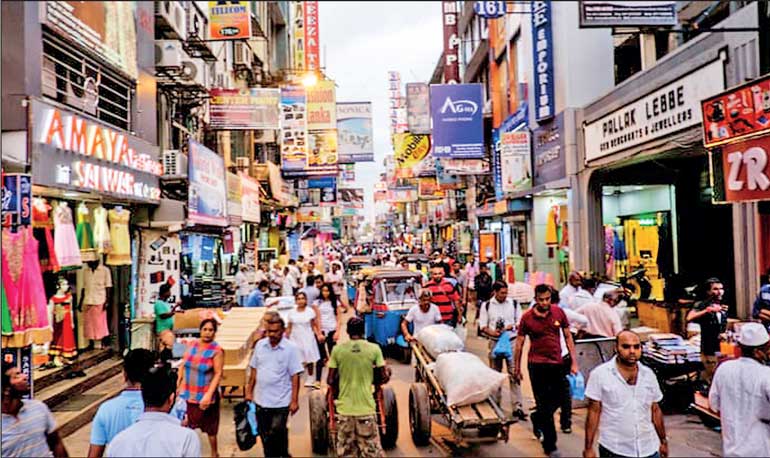Friday Nov 28, 2025
Friday Nov 28, 2025
Wednesday, 15 December 2021 00:00 - - {{hitsCtrl.values.hits}}

Pettah has always been a busy place. It was created to be busy. It ought to be like that
We have already killed some of Pettah’s iconic sites. To name a few: St. John’s Fish Market, Tripoli Market, Chalmers Granary, many small shops and boutiques that were located on WE Bastian Mawatha (current Floating Market area) and Manning Vegetable and Fresh Fruit Market.
Market, Chalmers Granary, many small shops and boutiques that were located on WE Bastian Mawatha (current Floating Market area) and Manning Vegetable and Fresh Fruit Market.
What is next to go is anybody’s guess.
The above sites existed since colonial days. The authorities destroyed them in the last 30 years (many in the last 10 years).
Why? Only the authorities know.
Perhaps they thought Pettah was too busy – that Pettah is overcrowded and we must reduce its business. Perhaps they want Pettah to be a peace and tranquil place. Perhaps they had other ideas, like earning money illegally.
Pettah has always been a busy place. It was created to be busy. It ought to be like that.
Even prior to the arrival of the colonials, Pettah was a major trading hub. Due to its proximity to Colombo Port (Kolom Thota), the Kotte kings erected warehouses in Pettah to store spices, vegetables, fruits, grains, ivory and timber geared for export. Pettah (also, Fort) used to station tusker elephants that Sri Lanka (then Sinhale) exported to the world.
One reason why the Portuguese wanted to conquer Sri Lanka was Pettah. They saw the very effective trade and commerce that was conducted around the Colombo Port. They were very impressed with Pettah. Due to the presence of the large number of Muslim traders (from the Middle East), Petah was then a cosmopolitan place (in 1505).
In Pettah, the Dutch built many infrastructures. Some of the buildings include the Old Town Hall, Dutch Museum, St. Phillip Neri’s Catholic Church and several small Christian Reformed (Protestant) churches. It is a shame that the Old Dutch Hospital (in Fort) was converted to an eatery (where among other restaurants a world-famous crab restaurant is currently located). If the Old Dutch Hospital was persevered in its original glory, it would have become an instant tourist site.
During the Dutch and the British periods, Pettah had emerged as the country’s main trading hub.
It continues to be the case.
In and around Pettah, the British built/improved such institutions as the Central Bus Stand, Fort Railway Station, Tram Station, St. John’s Fish Market, Front Street’s electrical appliances, bags and clock/watch centres, food wholesalers around Bankshall, China, Wolfendhal Streets and Gabo Lane areas, stationery shops in Maliban Street, textile wholesalers in Main and Keyzer Streets, Manning Market (Vegetable and Fruit), picture framers and glass dealers in Prince Street, a Gold City in Sea Street, Tripoli Market, many shops and boutiques in Pettah’s various Cross Streets including the 1st to 4th Cross Streets, Chalmers Granary, small eateries and tea boutiques on WE Bastian Mawatha, plus ample opportunities for pavement hawkers who traded from trinkets to motor vehicles!. Then, the nearby Hultsdorf Court complex where several thousands of lawyers, judges, litigants court staff converged daily.
The Sri Bodhirajah Vihraya (temple) situated adjacent to the SLTB bus terminal has existed since time immemorial albeit in a different form to today.
Due to these, Pettah has always been an exceptionally busy place.
It is due to Pettah’s busyness that it has become such an interesting/lively place.
In fact, it is a world-famous place. Overseas visitors to this country flock to see Pettah. They love the hustle and bustle there. The many street food outlets, the Dutch Period Museum and the Red Mosque are very favourite tourist attractions.
When promoting Sri Lanka, the travel guide books insist that tourists visit Pettah. But today as several important famous Pettah sites are removed/killed, there is hardly anything exciting for the tourists to see. We must not forget that the world-famous vlogger Harald Baldr did two YouTube episodes on Manning Market in 2019; the number of viewers exceeded two million. Sadly, that market is disappeared forever.
Except for the shops and crowds in the four cross streets (1st to 4th), narrow by-roads, Sea Street and the Central Bus Stand; there is not much exciting left in Pettah.
Due to the authorities’ desire to kill Pettah (than building it), they relocated the St. John’s Fish Market and the Manning Market from Pettah to Peliyagoda. This was a major ill-conceived idea – a grave mistake on their part. The country did not achieve anything through these stupid decisions.
These two excellent infrastructures were built by the British. The Manning Market was built on the lines of London’s famous Borough Market. Those days, office workers after work used to patronise these two markets. These two markets brought forth much pomp and glory to Pettah. Again, we unnecessarily killed them off.
Now they are located in a difficult to reach place – Peliyagoda, about 10 km away from Pettah. Vendors complain that they have experienced a downfall in business in Peliyagoda. Some fish stall holders complain that parts of the fish market get flooded after heavy rains.
Tripoli Market was a very lively market. It was very crowded on weekends. It was famous for curd and treacle brought freshly from the producers of the deep south.
What the authorities are going to do with the Manning Market land is a ‘million-dollar’ question. As soon as the stall owners reluctantly vacated the market in April 2021, it was demolished in no time; at breakneck speed. Will it also be given to the Chinese? Yes, quite possible.
The writer states that as the Manning Market is now dead and gone, this very expensive landmass in the centre of Pettah must be used for a good public purpose. It belongs to the people, it is no one’s private property.
The writer suggests converting same to a public park with trees planted and benches, water ponds/fountains erected. People could sit and enjoy/relax in somewhat now less busy Pettah. Part of the area may be used to build a children’s play area, also a large multistorey car park (in the Railway Station end) as parking is a major problem in Pettah/Fort. After Vihara Maha Devi Park we do not have any good parks in Colombo (it is unfortunate that the beautiful, serene Nomads Cricket Ground (owned by the CMC) was killed to build the useless Nelum Pokuna).
Such a new park can become a huge tourist attraction.
It is good that the pavement hawkers have now returned to Pettah, though in a limited way. Without pavement hawkers, there will be no Pettah.
Again, it is ludicrous even to think that Pettah should be a calm/quiet place. It was never intended to be so.
Due to its close proximity to the Fort Railway Station and the Central Bus Stand (both SLTB and private), Pettah will continue to grow and stay busy. And we should build Pettah in that context.
The authorities should allow trade and commerce to flourish in Pettah steadily; not to kill them.
The areas around the SLTB and private bus stands are extremely unclean and unhygienic. They are eyesores. Why cannot the SLTB convert its well-built main bus terminal building to a modern shopping and office mall? The infrastructure is already there. Why cannot the SLTB keep the interior roads of their Pettah premises well tarmacked; also, neat and tidy?
The offensive smell that emanates from the Beira Lake especially from around Customs Office/Lake House areas is unbearable. It is difficult to fathom how staff are working in those offices. It is sad that the authorities do not pay attention to these (we want Sri Lanka to become the ‘Wonder of Asia!).
Many thousands frequent Pettah daily, including tourists.
It is good that new toilets (paid) have been built in Pettah, but they do not seem to be clean.
There is a plus point in the recently established ‘Pettah Floating Market’ (PFM), as it exposed Pettah’s magnificent waterfront. Previously it was covered by shops/boutiques of WE Bastian Mawatha (those shops/boutiques were demolished overnight; were their owners/occupiers duly compensated?). However, that part of the Beira Lake must have clean, fresh water – not artificially cleaned water. The current water seems to be toxic/harmful.
Unfortunately, there is a lack of commercial activity in PFM (even the Bake House seems to be dead). The current shops have less business. Part of the PFM must be developed into an open food court (Hela Bojun/Diyatha Uyana styles). As the eateries around the Central Bus Stand in Olcott/Bodhirajha Mawathas are not up to the standard and lack variety, it is a good idea to open up trendy cafes/coffee shops/tea shops/ice cream parlours in PFM’s railway track side. It will be an ideal area for romantic couples who seek privacy to spend time.
PFM’s Beira Lake bank should be converted to a walking promenade (perhaps akin to Sydney’s Darling Harbour promenade). A walking/jogging track can be established from Maradana Elphinstone junction to the end of WE Bastian Mawatha (the Olcott Mawatha intersection, opposite First Cross Street). More shady trees and benches are required on this stretch.
The recent establishment of the small shop owners’ stalls (next to the Central Bus Stand) where items like clothes, caps and footwear are sold is good. They seem to have good business. The bad thing is that it was built after shutting down the road behind the Bo Tree (Sri Bodhirajh Vihara). More Pettah streets must not be closed in the future. That will exacerbate not only Pettah’s traffic congestion but the entire city’s.
The condition of the new vegetable/fruit market (retail) established closer to Gaspaha Junction (opposite People’s Park Shopping Centre) is of menial standard. In an open shed like building vendors keep items on the floor as no proper stands/stalls have been erected. Erection of benches should be considered; keeping food on the floor is unattractive and unhygienic. This is a very basic facility; it resembles a village pola. There is no running water there. People can be seen washing vegetables and fruits using filthy water brought in small jars. Compared with what Pettah used to have – especially the British built Manning and Tripoli markets, what needs here is a better, high standard/sophisticated retail vegetable/fruit market.
True the authorities have killed some of the iconic sites of Pettah. Let’s hope they will not touch any more important sites. What they should do is to build/develop Pettah, not continue to kill Pettah.
(The writer is an international lawyer.)